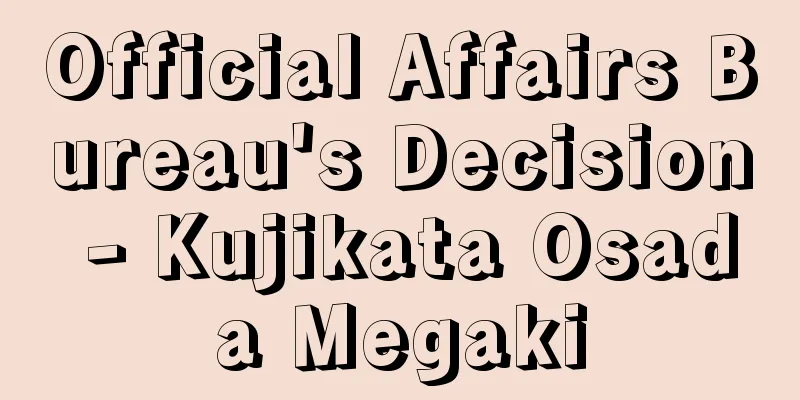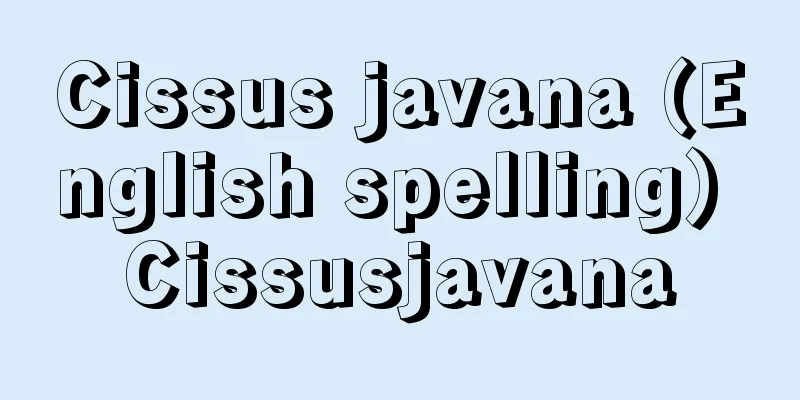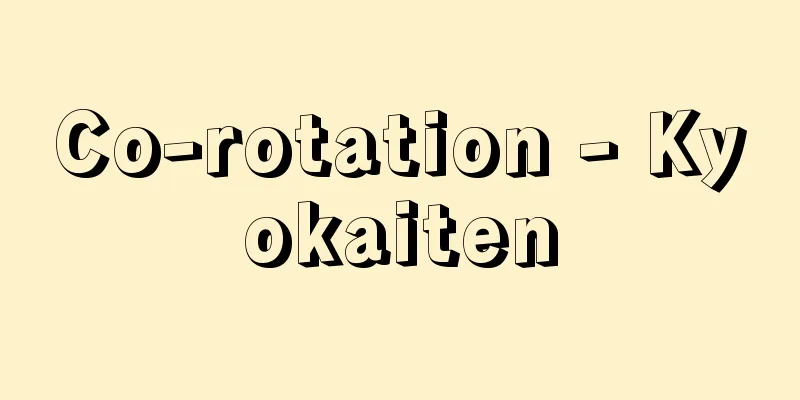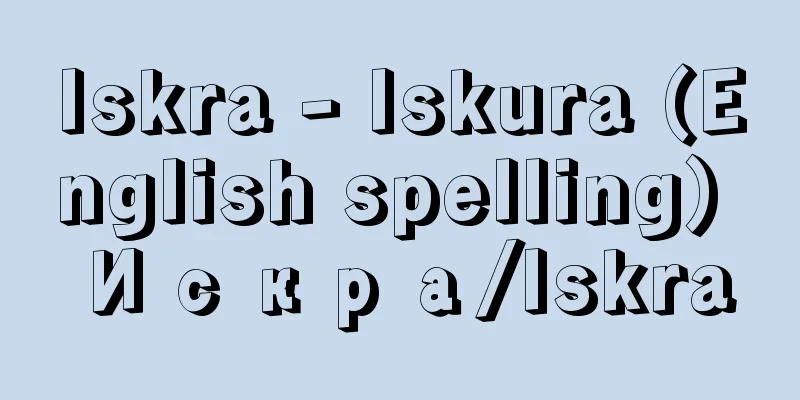Official Affairs Bureau's Decision - Kujikata Osada Megaki

|
This is the first collection of legal precedents compiled by the Edo Shogunate. It is also called the "Osamidaki Hyakujo." It consists of two volumes. The first volume is a collection of 81 articles, judicial notices and various regulations, while the second volume is the so-called Hyakujo, which actually consists of 103 articles and is divided into over 500 items. It is a compilation of regulations that should be the standard for judgments based on precedents and customs, with the majority being criminal-related. It is said that the compilation began in 1720 (Kyoho 5) when the eighth shogun, Tokugawa Yoshimune, ordered the Hyojosho to set standards for sentencing for various criminals in advance and to make mitigation decisions based on the severity of the crime. At that time, Town Magistrate Ooka Tadasuke was in charge, and in 1824 he submitted a collection of laws with 86 articles in 14 categories called "Kyoho Dohori Tsuruiyose." In 1837 (Genbun 2), the Hyojosho was once again ordered to compile a legal document, and Finance Magistrate Sugioka Yoshitsure was put in charge, and the prototype of the two volumes, one above the other, was completed the following year. Yoshitsure passed away that year, so Temples and Shrines Magistrate Makino Sadamichi, Town Magistrate Ishikawa Masatomo, and Finance Magistrate Mizuno Tadanobu took over the work, and they confirmed the Shogun Yoshimune's intentions for each article, completing the compilation in 1842 (Kanpo 2). After that, new legal precedents and corrections were added, but in 1745 (Enkyo 2), this was stopped and, as a rule, the text was compiled in the form of a "reisho" (precedent). In 1754 (Horeki 4), work began on arranging the various records related to the compilation of the Osamadhi by article, and this was completed in 1767 (Meiwa 4). This is called the "Kajo Ruiten (Classification of Laws and Regulations)." The Osamadhi was kept secret, and according to an order from the senior councilor Matsudaira Norisato, it was forbidden for anyone other than the magistrate to see it, but copies of the second volume in particular are in widespread circulation. The Osadamegaki is a collection of legal precedents and customs, not new laws, but only a quarter of the articles adopt examples from before the Kyoho era, while the rest were issued or revised during the Kyoho era. There are many passages that seem to reflect the will of Shogun Yoshimune, and they show how much effort the authorities put into improving the system and operation of the judicial system during the Kyoho reforms. The important political issues of the time can also be seen in the enactment and revision of legal texts. For example, the promotion of trials (Articles 42-47 of the Upper Law), the restriction of banishment (Article 52 of the Upper Law), the easing of cruel punishments (Article 40 of the Upper Law = Restrictions on Enza (Enza) and Article 83 of the Lower Law = Restrictions on Torture), the establishment of a statute of limitations (Article 18 of the Lower Law), and the prohibition of forced collection of documents for erroneous apologies (Article 16 of the Lower Law) are rational or civil reforms of the judicial system. The relaxation of penalties for the sale and purchase of farmland on a permanent basis (Article 30 below), rules relating to pawning land (Article 57 above, Articles 31 and 32 below), and rules relating to borrowing money (Articles 34 to 40 below) all reflect the trends of the times, in which finance and credit transactions became more complex and agricultural land relations changed. Furthermore, the codification of penalties for peasant uprisings, and in particular the inclusion of punishment for the flight of feudal lords and magistrates in cases of illegal conduct, which had been tolerated since 1643 (Kan'ei 20) (Article 28 below), show the attitude of the authorities, who had lost their tolerance for the intensifying resistance of peasants. The Osamadho had a major impact on subsequent court cases, and is said to have given rise to the bad practice of sticking to the wording of the articles. [Tatsuya Tsuji] "Keita Kazuko, 'Research on the Edo Shogunate Law' (1980, Gannando Shoten)" Source: Shogakukan Encyclopedia Nipponica About Encyclopedia Nipponica Information | Legend |
|
江戸幕府が初めて編纂(へんさん)した裁断判例集。「御定書百箇条」とも称せられる。上下2巻。上巻は81条、司法関係の触書(ふれがき)や諸例規を集め、下巻がいわゆる百箇条で、実際には103条からなり、500項目余りに分かれ、判例や慣習に基づいて、判決の基準となるべき条例を編纂したもので、刑事関係が過半を占めている。編纂の発端は1720年(享保5)8代将軍徳川吉宗(よしむね)が評定所(ひょうじょうしょ)に対し、各種犯罪者に対する量刑の基準をあらかじめ設定しておき、個々の判決に際しては罪の軽重を勘考して加減するように命じたことにあるといわれる。このときは町奉行(ぶぎょう)大岡忠相(ただすけ)が担当し、24年「享保度法律類寄(きょうほうどほうりつるいよせ)」という14類86条の法規集として呈出した。37年(元文2)に至り、改めて評定所に御定書編纂の命令が下り、勘定奉行杉岡能連(よしつれ)が主任となり、翌年上下2巻の原型が成立した。この年能連が死去したので、寺社奉行牧野貞通(さだみち)、町奉行石河政朝(いしこまさとも)、勘定奉行水野忠伸(ただのぶ)が担当し、条文ごとに将軍吉宗の意向を確かめつつ、42年(寛保2)に編纂を完了した。その後新判例や訂正を追加していったが、45年(延享2)に至ってこれをやめ、その後は原則として「例書」という形でまとめることとなった。また54年(宝暦4)から御定書編纂に関する諸記録文書類を各条文ごとに配列する編纂が開始せられ、1767年(明和4)に完成した。これを「科条類典」という。御定書は秘密文書とされ、奉行のほか他見を禁ずる旨老中松平乗邑(のりさと)の申渡しがあるが、とくに下巻は写本がかなり広く流布している。 御定書は判例や慣習の集成であって新法の制定ではないが、享保以前からの例を採用した項目は4分の1ほどで、他は享保期に発布または改訂をみたものである。ことに将軍吉宗の意向が反映しているとみられる箇所が多数あり、享保の改革において司法関係の制度上運用上の改善に当局者がいかに力を注いだかをしのばせるとともに、この時期の政治上の重要課題を法文の制定や改訂のなかに読み取ることができる。たとえば審理の促進(上42~47条)、追放の制限(上52条)、残酷な刑罰の緩和(上40条=縁坐(えんざ)の制限、下83条=拷問の制限)、時効の制定(下18条)、誤(謝)証文(あやまりじょうもん)強制徴取の禁止(下16条)などは司法制度の合理的または文治的改革である。また田畑永代売買の罰則緩和(下30条)や質地関係諸規則(上57条、下31・32条)、借金銀関係諸規則(下34~40条)などからは、金融や信用取引の繁雑化と農地関係の変動という時代の趨勢(すうせい)がうかがえる。さらに百姓一揆(いっき)の罰則の成文化、ことに1643年(寛永20)以来容認されていた領主・代官非法ある場合の逃散(ちょうさん)も処罰の対象としたこと(下28条)は、激化する農民の抵抗に寛容性を失った当局の姿勢が示されている。御定書はこの後の裁判に大きく影響し、条文に拘泥する弊を生ぜしめていったという。 [辻 達也] 『茎田佳寿子著『江戸幕府法の研究』(1980・巌南堂書店)』 出典 小学館 日本大百科全書(ニッポニカ)日本大百科全書(ニッポニカ)について 情報 | 凡例 |
<<: Gushikami [village] - Gushikami
>>: Kushigata [town] - Kushigata
Recommend
Kurbinovo
...One of the masterpieces of Komnenoid painting ...
Kakyoshi - Kakyoshi
…The first official specializing in shipping was ...
Digital
...An annual grass of the grass family commonly f...
Scythian lamb
…The rhizome and the base of the petiole can be c...
Asogo - Let's play
…The Yoshioka Copper Mine is known as one of the ...
Thymocyte
…There are three types of cells in both the corte...
Abe Moritaro Assassination Case
This was an incident in which Abe Shutaro, Directo...
Nijo Michihira
Year of death: 27th February 1335 Year of birth: 1...
Machine binding - Machine binding
…The signatures for one book are called a “piece....
Santonin - Santonin (English spelling)
Anthelmintic drug. It is a colorless crystal or w...
Upasi - Ubai
〘Noun〙 (Transliteration of upâsikā) Buddhist term....
Tyndall phenomena
There are many books that refer to this phenomenon...
Ginger beer (English spelling)
…It can be chilled and drunk as is, mixed with wh...
Basket Shingen
…Until the 1880s, women's belongings mainly c...
Alumni Association - Gakuyukai
…〈douson〉 is a Chinese word meaning friends who s...









